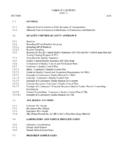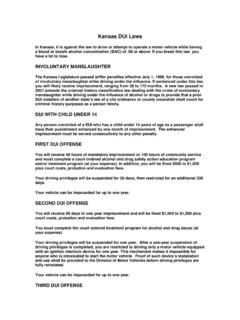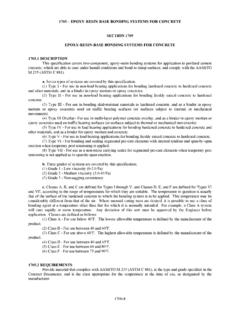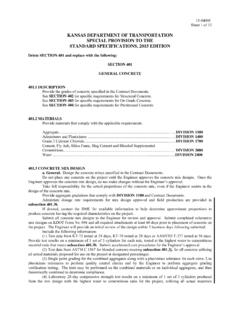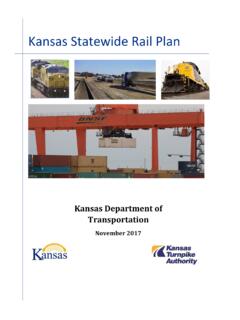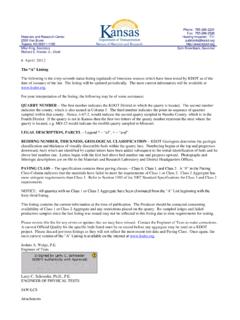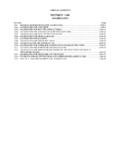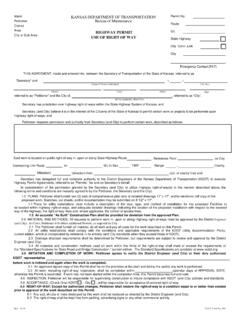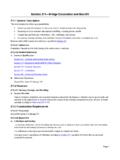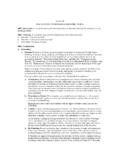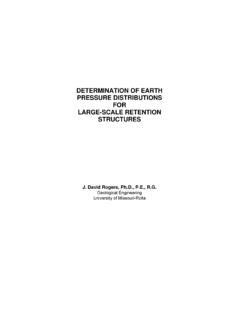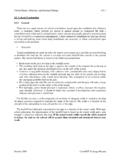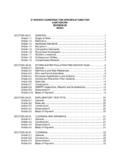Transcription of 204 - EXCAVATION AND BACKFILL FOR …
1 204 - EXCAVATION AND BACKFILL FOR STRUCTURES SECTION 204 excavation and backfill for STRUCTURES DESCRIPTION Excavate for the structures as shown in the Contract Documents. Unless specified otherwise, BACKFILL the completed structures to the original ground line. BID ITEMS UNITS Class * EXCAVATION Cubic Yard Concrete (Grade **)(**) Cubic Yard Concrete for Seal Course (Set Price) Cubic Yard Foundation Stabilization Cubic Yard Foundation Stabilization (Set Price)
2 Cubic Yard Granular BACKFILL Cubic Yard Granular BACKFILL (Wingwalls) (Set Price) Cubic Yard Water (Grading) (Set Price) M Gallon *Class of EXCAVATION **Grade of Concrete **AE (air-entrained), if specified MATERIALS Provide materials that comply with the applicable requirements. Concrete.
3 DIVISION 400 Aggregates for BACKFILL ..DIVISION 1100 Water ..DIVISION 2400 Provide sand, or other aggregate that contains sufficient binder to allow compaction and limit the flow of water through the material, as granular material for culvert bedding. Provide material with enough moisture to allow compaction. The Engineer will accept the granular bedding material based on visual inspection of the material placed on the project. CONSTRUCTION REQUIREMENTS a. Classification of EXCAVATION . (1) Class I EXCAVATION and Class II EXCAVATION . EXCAVATION for bridges is normally classified as Class I and Class II EXCAVATION .
4 Class I and Class II EXCAVATION are referenced to the EXCAVATION Boundary Plane (a horizontal plane at a given elevation) shown in the Contract Documents. (a) Class I EXCAVATION is the entire volume of whatever nature, except water, found above the EXCAVATION Boundary Plane, within the limits specified. (b) Class II EXCAVATION is the entire volume of whatever nature, including water, found below the EXCAVATION Boundary Plane, within the limits specified. (2) Class III EXCAVATION . Bridge EXCAVATION not classified as Class I or Class II, is classified as Class III EXCAVATION . EXCAVATION for structures other than bridges is also classified as Class III EXCAVATION .
5 (a) Class III EXCAVATION is the entire volume of whatever nature encountered, including water, within the limits specified. The water level for determining quantities is the water level during construction at which pumping or bailing is necessary to continue EXCAVATION . b. EXCAVATION Requirements. (1) General. Allow the Engineer to define the limits of the EXCAVATION and cross-section the original ground before beginning the EXCAVATION for the structure . 200-5 204 - EXCAVATION AND BACKFILL FOR STRUCTURES Excavate all foundations to the elevations and dimensions shown in the Contract Documents.
6 If rock of the quality that will not erode is encountered in the toe wall EXCAVATION , the Engineer may allow the toe wall to be keyed into the rock. Follow OSHA safety regulations for sloping the sides of excavations , using shoring and bracing as required. If material encountered below the foundation elevation will not support the structure , remove such material and replace with stable BACKFILL material approved by the Engineer. Save excavated material for structure BACKFILL . Dispose of surplus excavated material and excavated material unsuitable as BACKFILL material. Provide temporary erosion and pollution control according to SECTION 901.
7 (2) Cofferdams. Use watertight cofferdams if excavating in water, or if the EXCAVATION is affected by groundwater. Construct and shore the cofferdams according to OSHA safety regulations. The minimum size of the cofferdams shall be greater than the limits for pay EXCAVATION . Extend the cofferdams below the bottom of the footing, or at least to an elevation as near the bottom of the EXCAVATION as foundation conditions will allow. If necessary, dewater the cofferdams. (3) Foundations with Piling. Complete the foundation EXCAVATION before driving any piling. After driving all piling, remove the loose and displaced material in the foundation pit.
8 If necessary, reshape and recompact the bottom of the EXCAVATION according to the Contract Documents. (4) Spread Footing Bridge Foundations. From the elevation that rock or shale is encountered or from the top elevation of the footing, whichever is lower, excavate the footing as shown in the Contract Documents. No side forming is allowed below the top elevation of rock or shale, or below the top of the footing, whichever is lower. Cut spread footing bridge foundations in rock, using hand equipment. Do not use blasting or machine rock EXCAVATION below the top of the footing. If the bottom elevation of the spread footing EXCAVATION is in shale, minimize the time the shale is exposed to the elements before placing the concrete footing.
9 Place the concrete footing within the time limits designated in the Contract Documents. Contact the KDOT Regional Geologist if the shale exposure exceeds the maximum time specified. Mitigate the effects of the shale exposure by excavating a minimum of 4 inches below the over-exposed shale to expose sound material. The Contractor has the option (at own expense) to negate the time limits imposed for exposure of the shale by placing a 4 inch (minimum) concrete seal of Grade concrete over the exposed shale before the specified time limits expire. If the Contractor chooses this option, excavate to 4 inches below the plan bottom of footing elevation so the bottom of footing elevation remains at the elevation designated by the Contract Documents.
10 After the EXCAVATION is completed, and all loose material is removed from the footing, drill exploratory borings 1 to 2 inches in diameter and 5 foot deep to verify the quality and soundness of the material below the bottom of the footing. Notify the Engineer before starting the exploratory borings. For footings with an area of less than 12 square yards, drill the boring in the center of the footing. For footings with an area of 12 square yards or greater, drill a boring within 3 feet of each corner of the footing. If an exploratory boring encounters unsound material, or if the material at the bottom of the footing does not match the material shown on the geology sheet in the Contract Documents, do not proceed with the construction of the spread footing until the site is reviewed by the Geologist and a recommended course of action made.
